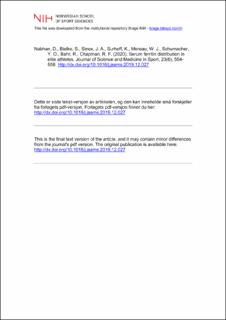| dc.contributor.author | Nabhan, Dustin | |
| dc.contributor.author | Bielko, Shane | |
| dc.contributor.author | Sinex, Jacob A. | |
| dc.contributor.author | Surhoff, Kendall | |
| dc.contributor.author | Moreau, William J. | |
| dc.contributor.author | Schumacher, Yorch Olaf | |
| dc.contributor.author | Bahr, Roald | |
| dc.contributor.author | Chapman, Robert F | |
| dc.date.accessioned | 2021-12-08T08:31:08Z | |
| dc.date.available | 2021-12-08T08:31:08Z | |
| dc.date.created | 2020-01-28T14:12:46Z | |
| dc.date.issued | 2019 | |
| dc.identifier.citation | Journal of Science and Medicine in Sport. 2019, 23(6), 554-558. | en_US |
| dc.identifier.issn | 1440-2440 | |
| dc.identifier.uri | https://hdl.handle.net/11250/2833269 | |
| dc.description | Dette er siste tekst-versjon av artikkelen, og den kan inneholde små forskjeller fra forlagets pdf-versjon. Forlagets pdf-versjon finner du her: https://doi.org/10.1016/j.jsams.2019.12.027 / This is the final text version of the article, and it may contain minor differences from the journal's pdf version. The original publication is available here: https://doi.org/10.1016/j.jsams.2019.12.027 | en_US |
| dc.description.abstract | Objectives: It is not uncommon for athletes to be diagnosed with iron deficiency, yet there remains uncertainty whether the prevalence of suboptimal iron status in elite athletes differs from the normal population or warrants routine screening. The purpose of this study is to describe the distribution of serum ferritin (SF) in a cohort of elite athletes. Design: Retrospective cohort study. Methods: Electronic health records of 1085 elite adult athletes (570 women, 515 men) from 2012–2017 were examined retrospectively. SF values were compared to published normal population data. The proportion of athletes meeting criterion values for iron deficiency or initiation of treatment was examined. Results: SF distributions in male athletes were significantly lower than normal males aged 20 to <24 yrs. (χ2 28.8, p < 0.001) and aged 24 to <28 yrs. (χ2 91.9, p < 0.001). SF status was similar in female athletes and normal women aged 20 to <24 yrs. (χ2 9.5, p > 0.05) or aged 24 to <28 yrs. (χ2 11.5, p > 0.05). Using 35 ng/ml as the criterion value for stage one iron deficiency, 15% of male athletes and 52% of female athletes displayed suboptimal iron status. Conclusions: Male athletes have a significantly lower population distribution of SF values as compared to normative data on healthy males, with 15% of male athletes having suboptimal SF status. The distribution of SF values in elite female athletes did not differ from population values, however approximately half women athletes were iron deficient. These data suggest that iron screening should be considered in both male and female athlete populations. | en_US |
| dc.language.iso | eng | en_US |
| dc.subject | iron supplementation | en_US |
| dc.subject | iron deficiency | en_US |
| dc.subject | exercise | en_US |
| dc.subject | sex differences | en_US |
| dc.title | Serum ferritin distribution in elite athletes | en_US |
| dc.type | Peer reviewed | en_US |
| dc.type | Journal article | en_US |
| dc.description.version | acceptedVersion | en_US |
| dc.source.pagenumber | 554-558 | en_US |
| dc.source.volume | 23 | en_US |
| dc.source.journal | Journal of Science and Medicine in Sport | en_US |
| dc.source.issue | 6 | en_US |
| dc.identifier.doi | 10.1016/j.jsams.2019.12.027 | |
| dc.identifier.cristin | 1784261 | |
| dc.description.localcode | Institutt for idrettsmedisinske fag / Department of sports medicine | en_US |
| cristin.ispublished | true | |
| cristin.fulltext | postprint | |
| cristin.qualitycode | 1 | |
